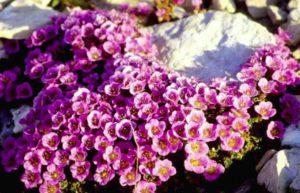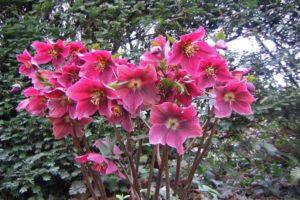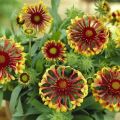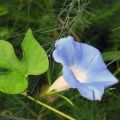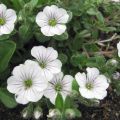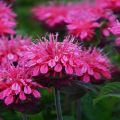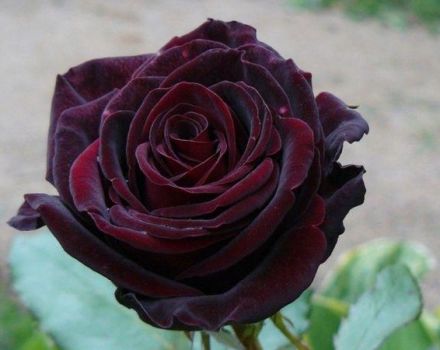Description of varieties and cultivation of perennial escholzia, planting and care
Escholzia is a great decoration for any place where it is grown. Flowers do not require special care, which allows even inexperienced gardeners to deal with them. The perennial flowers of the Escholzia planted in a flowerbed look like small lakes with a surface swaying in the wind.
There are several types and varieties of this plant, among which the gardener can choose the most suitable option for him. In areas with cold winters, it is used as an annual plant due to its vulnerability to cold.
Description and features
Eshsholzia perennial is one of the species of the Makov family. Her homeland is the west of North America. The plant came to the European continent in the 18th century. Eshsholzia perennial has another name: "Californian poppy". It is also called "wormwood" due to the fact that the stems and leaves resemble wormwood.
Eshsholzia perennial is a perennial plant. She has a powerful core rhizome. Flowers have erect and branched shoots. Eshsholzia perennial grows up to 40 centimeters.
Stems of a ribbed structure of dark green color, along which foliage is attached on long petioles.
Flowers by their design copy the bells. They also appear to be terry or ordinary. Flowering continues throughout the summer. The bud lives no more than four days, but new ones appear constantly.
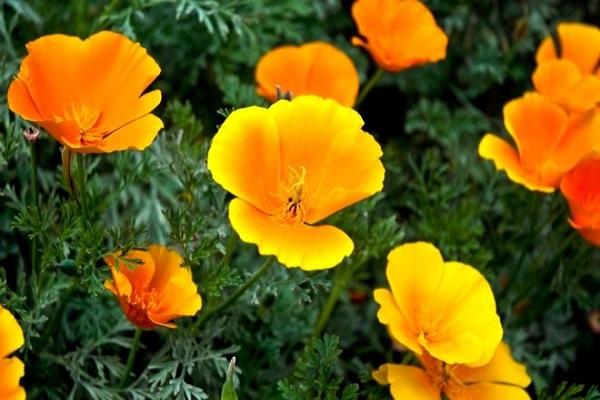
In unfavorable weather and at night, the flowers close. You can admire them only in the daytime.
The perennial escholzia flower looks like a poppy. It can be white, yellow, orange and red. The petals are beautifully arranged in several tiers.
After pollination has passed, seed pods are formed in a month. They are oblong in shape and look like long, fleshy pods that are 7 centimeters long. The capsules contain small, gray-brown elliptical seeds.
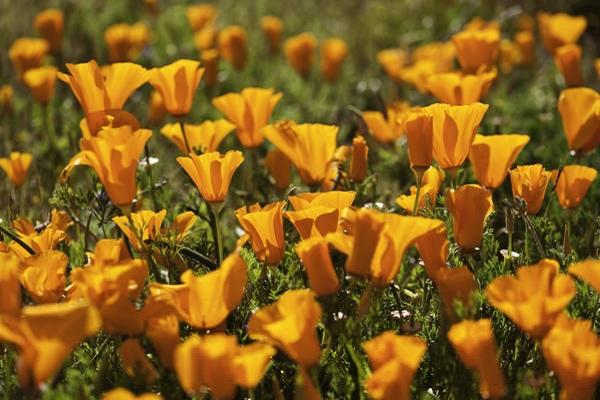
Features of sowing at different times
When sown in autumn, plants begin to bloom earlier than those planted in spring.
Autumn
Eshsholzia perennial reproduces well by self-seeding. During the winter, the lowest quality seed will die. In the spring, the most viable seeds will sprout.
Spring
The collected seeds are mixed with sand and placed in paper bags. Store in the refrigerator until spring.Sow as soon as the ground warms up.
Before winter
Seeds can be planted in open ground just before the onset of the winter cold. At the first sign of warmth, they will sprout and may bloom in May.
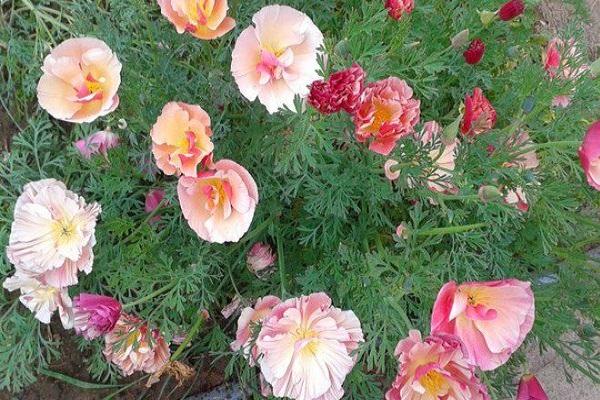
Growing seedlings at home
The use of seedlings is common in areas with cold climates. The difficulty lies in the fact that the escholzia has a long-term powerful root shaft, which can easily be damaged during transplantation. In this regard, it is recommended to grow seedlings using peat tablets.
First, cold stratification of the seeds must be carried out within two weeks. In early March, they are planted in peat tablets. They are placed in a container, which must be placed in a place with good lighting and a temperature of 20-22 degrees.
At the end of April, seedlings are hardened. The containers are briefly taken out into the street in order to accustom the perennial escholzia to the desired temperature. In early May, seedlings can be planted in open ground.
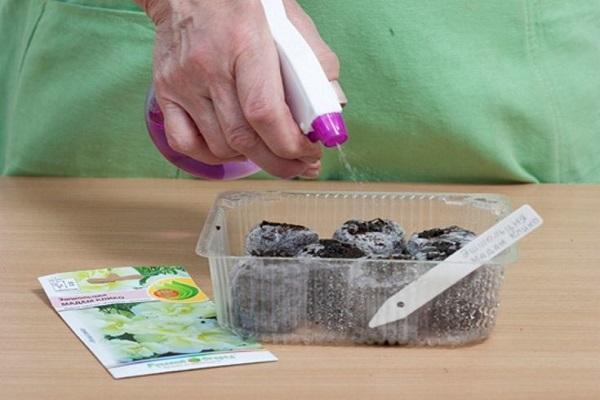
How to plant in open ground
You can plant these flowers with seeds or seedlings.
Soil preparation
Before planting a perennial escholzia, the soil must be dug up. If you have to grow flowers in heavy and clay soil, you need to add peat and sand. For perennial escholzia, neutral or slightly acidic soil is best suited.
Too acidic soil must be mixed with dolomite flour or ash.
Seat selection
For planting, loose sandy loam soil is preferable. It is important for flowers that the lighting is good.
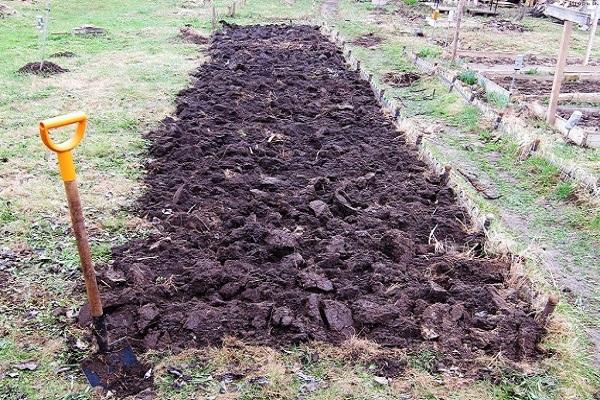
Seed preparation
They are stratified by keeping at temperatures up to 3 degrees Celsius for 1-1.5 months. If sowing is done in autumn, this will be done automatically during the winter period. In this case, weak seeds die, and viable ones will be planted in the ground.
Landing scheme
For planting in the ground, grooves are made into which seeds are placed. Pour 2 cm of earth on top. Mulching with peat is carried out. If the planting was done in the fall, I cover the seeds with a layer of fallen leaves.
When planting seedlings, it is necessary that the root collar is located on the surface of the soil.
The optimum distance between plants is 30 centimeters.
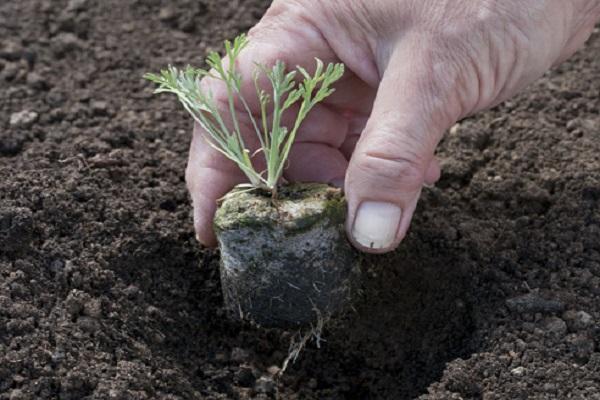
Care
Eshsholzia perennial does not require special additional care. However, it is necessary to take care of it so that it pleases with luxurious flowering.
This plant may suffer from overgrowth of weeds. Therefore, this must be monitored and weeded in time. For perennial escholtsia, it is useful to regularly loosen the soil. As a result of processing, air penetrates better to the roots, and this contributes to improved growth and development.
If withered flowers are found, they are pruned.
Eshsholzia perennial is able to tolerate high temperatures well, but has poor resistance to frost. She is able to withstand only brief freezing with temperatures up to 5 degrees below zero..
Due to its poor cold tolerance, it is often grown as an annual plant in temperate climates.
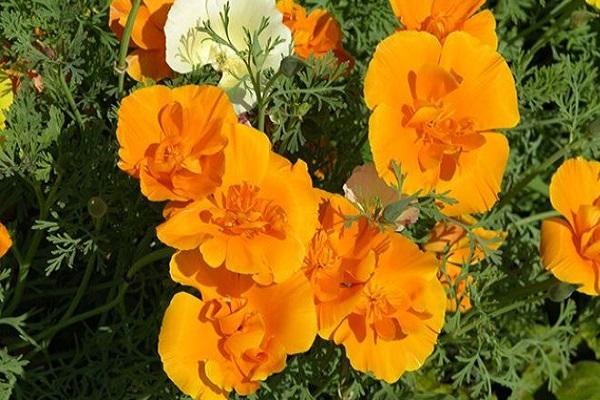
Watering
Eshsholzia perennial loves moisture. Accordingly, it is necessary to provide her with punctual watering, the frequency of which will be regular from two to three times throughout the week. Moreover, you should monitor the total humidity and be limited to a moderate amount of liquid used for irrigation, so that there is no overflow. It is recommended to perform it in the evening, when it is not as hot as during the day.
Eshsholzia turfy requires less moisture and tolerates dry weather well.
Top dressing
Fertilized several times a year. In the summer, one or two fertilizing with mineral compositions is enough for flowering plants.
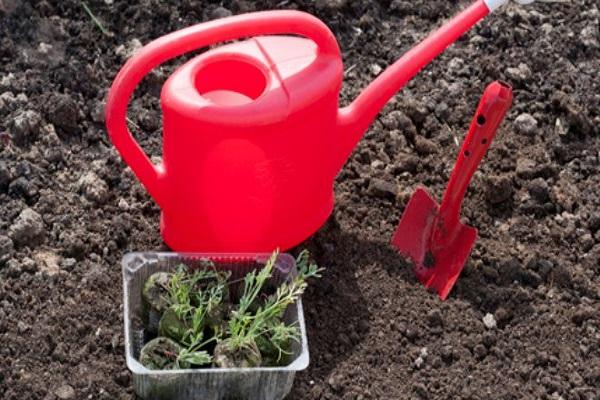
Diseases and pests
Echscholzia perennial is susceptible to attack by spider mites or bean aphids in hot dry weather. An effective remedy against them is insecticide spraying.To do this, use:
- Aktara;
- Commander.
With excess moisture, powdery mildew or root rot develops. A sign of infection is the growth of small leaves that turn yellow. When a viral infection is detected, the plants are destroyed. If a fungal infection has occurred, fungicides are used.
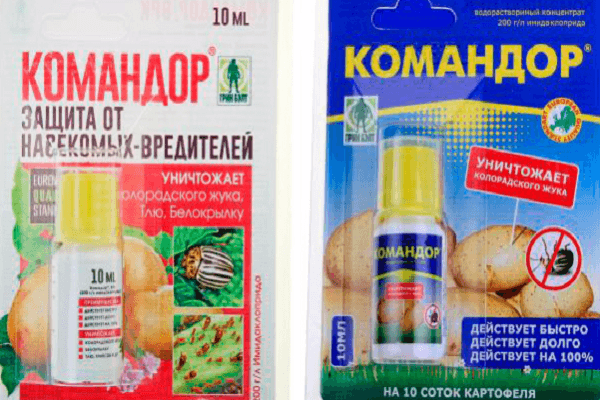
Healing properties
This plant is known for its medicinal properties. The juice contains:
- flavonoids;
- dyes;
- alkaloids.
To obtain, the aerial part of the plant is used. It is cut during the flowering period, then dried.
Dyes are used to create cosmetics. Alkaloids can be used for medicinal purposes. They are used as sedatives for pain relief. Alkaloids have an antispasmodic effect.

From this plant, gelatin tablets, liquid extracts, and alcohol settings are prepared.
The use of perennial escholtia as a medicine is recognized in traditional medicine. It is known that lotions with this remedy can help with toothache. Eschsholzia perennial can be used to combat insomnia. It is prescribed for children as a remedy for enuresis.
There are contraindications for the use of medicines made from this plant. It is not recommended to take them:
- pregnant women;
- nursing mothers;
- those who have a long-term allergy to eschscholtia.
Children are advised to use these medicines only as directed by their doctor. If the activity requires an increased concentration of attention, the use of a product based on this plant should be limited.
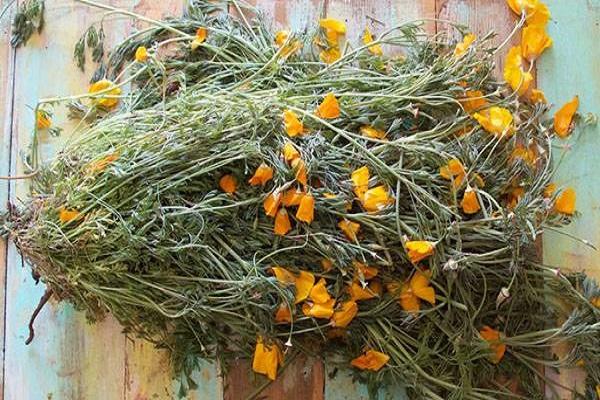
Collection and storage of seeds
In order to collect the seeds, you need to wait for the seed pods to appear on the plant. It is recommended to place them, without tearing, in a gauze bag and wait for 4 weeks until they are completely dry.
Then they are torn off and carefully poured onto a piece of paper. They are dried and poured into paper bags. It is recommended to store seeds on the bottom shelf of the refrigerator. They do not lose germination for three years.
Kinds
There are 12 types of escholzia. The most common are 2 of them.
California
This plant has thin and branched shoots. Dark green openwork leaves are covered with a bluish bloom. The plant grows up to 40 centimeters. Some of the processes lie on the ground.
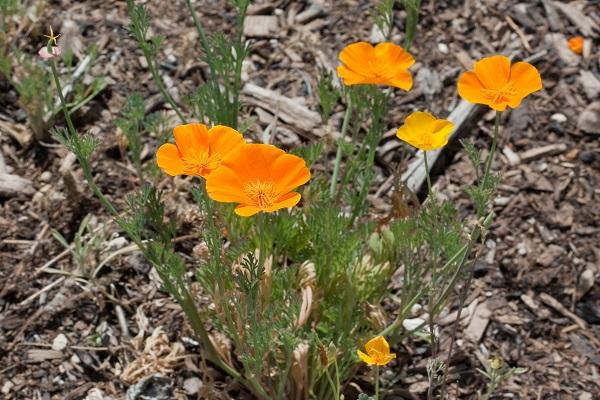
The plant has bowl-shaped bright orange flowers with a diameter of 9 centimeters. Flowering begins in mid-June and continues until the end of autumn and the onset of winter cold.
Soddy
This is an annual species. It has a compact size. Plant height is 15-29 centimeters. The leaves are openwork, collected in basal rosettes. Simple flowers with a diameter of 3 centimeters grow on bare stems. Flowering begins in June.
Lobby
The flowers are pale yellow. The diameter is 2 centimeters. The height of the bushes does not exceed 20 centimeters.
Terry
This species has double flowers of white, cream, pink or carmine color. The edges of the petals can be jagged or smooth. This species is unpretentious, resistant to drought, usually reproduces by self-seeding.
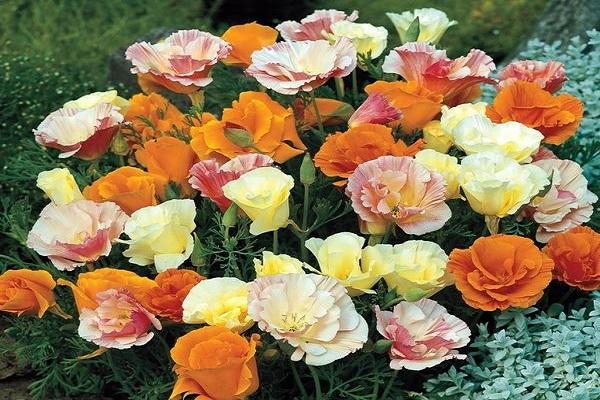
Popular varieties
Apricot chiffon
The perennial escholzia bushes are covered with flowers of a creamy apricot hue. They grow up to a height of 35-40 centimeters. Flowers of this variety are double with corrugated petals.
Golden glory
Large simple yellow flowers with an orange center.
Orange king
Has bright orange inflorescences. The diameter of the flower is 5-8 centimeters. It blooms from June to October.
Mikado
This variety belongs to the Californian escholzia. It has bright yellow flowers with an orange center 7 centimeters in diameter.
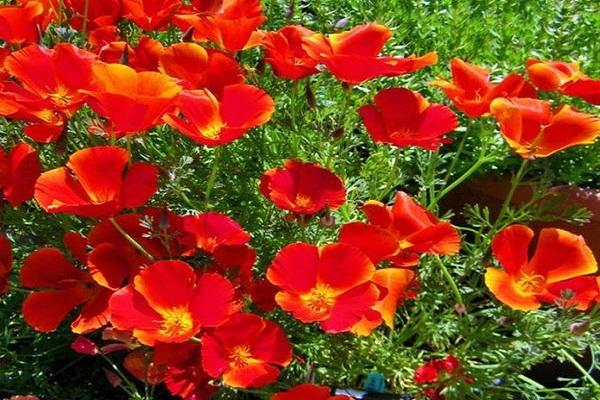
Karminkoenig
Simple flowers are dark carmine in color.
Strawberry fields
This variety has semi-double flowers, scarlet with a yellowish middle.
Fruit explosion
The name of the colors comes from a combination of bright, saturated colors of yellow and crimson, in their shape they can be wide and folded.
Apple tree flowers
The varietal species is distinguished by the increased color of large inflorescences. Their color is pink, but they have a bright shade at the edges, and pale in the middle.
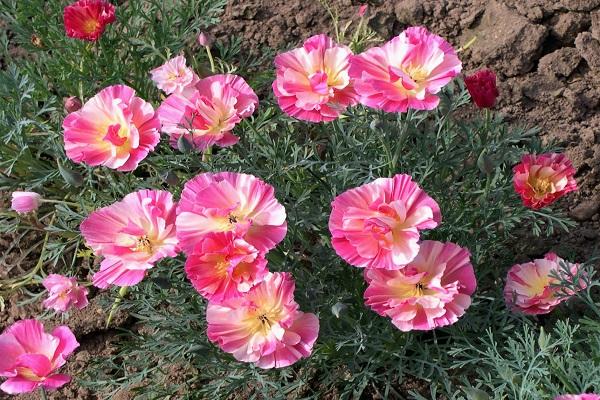
Ballerina
In the perennial escholzia, double bright flowers have a diameter of 15 centimeters. They can be yellow, pink or orange in color. The leaves, cut three times, have a waxy coating.
This plant is beautiful and there are no special difficulties when growing it. For these and other reasons, the delicate and delicate flowers of Escholzia attract many people.
